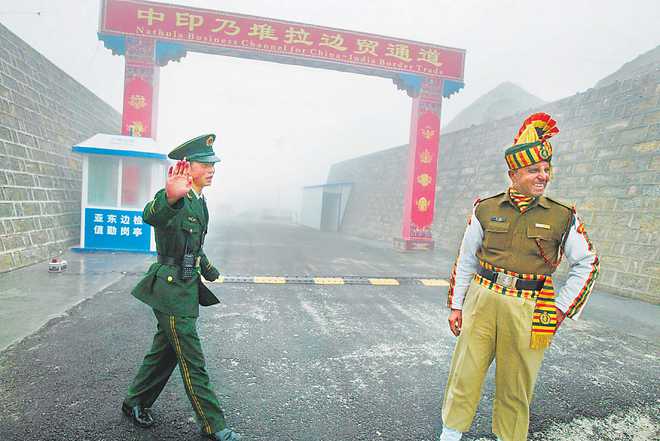
This file photo of 2008 shows a Chinese and an Indian soldier at the Nathu La border crossing between India and China in Sikkim. AFP
Pravin Sawhney
Editor, FORCE newsmagazineRENDERING a degree of permanence to its presence at the Doklam plateau, the Chinese have built roads, defences, pre-fabricated snow shelters, fighting and communication trenches, storage sites and helipads at the disputed territory also claimed by Bhutan. These are enough to accommodate over 1,800 Chinese border guards. These structures are about 7 km east of the stand-off site — also on Doklam plateau — between India and China.On June 16, Chinese border guards had sought to build a road close to Indian Army’s positions which India believed made the Chicken’s Neck area militarily vulnerable. Instead of accepting China’s offer of talks, the Indian Army, on the plea that Bhutan had sought its help under the 2007 bilateral friendship treaty, blocked Chinese construction on June 18, leading to the 73-day military standoff. Disengagement of troops happened on August 28 once the Chinese agreed to stop constructing that road. Indian soldiers withdrew from Doklam; the Chinese did not. On the new constructions by China in Doklam, India says they do not concern it as long as the status quo at the standoff site holds.
Difficult situation for Bhutan
This situation has left the King of sovereign Bhutan, Jigme Khesar Namgyel Wangchuck, also the commander-in-chief of the 9,000-strong Royal Bhutan Army, facing an unprecedented and difficult situation. For the first time, he has two rival militaries on his soil: Indian and Chinese.The Indian Military Training Team (IMTRAT), located at the picturesque Haa town since 1962 under bilateral treaties (1949 and now 2007), is meant to train Bhutanese soldiers and border guards. Its unsaid task is to be the eyes and ears of both Indian Army and Air Force’s eastern commands responsible for the Chinese theatre, as well as the protection of Bhutan.And now, Chinese soldiers too have entrenched themselves on its claimed territory. By now accepting the Chinese presence on ‘Bhutanese territory’ India is conveying the message to Thimpu that as long as the Siliguri Corridor is secure, the Chinese machination does not bother it.Given this, how long can Bhutan keep its side of the friendship with India? In 24 rounds of border resolution talks with China, Thimpu had consistently rejected the Chinese offer of a land swap — 495 sqkm of Chinese territory in eastern and central Bhutan (including grazing ground for cattle) for 269 sqkm in Doklam — to protect India’s security interests.If Bhutan were to resolve its border dispute with China, it could get the following: $10 billion development loan promised by China; road and railway network across the 470km-border that it has with China to boost its tourism industry; end to perceived hydro-electric power exploitation by India; and importantly, removal of foreign troops from its soil, as IMTRAT will have to be wound up. Interestingly, the Chinese troops will remain in Doklam, which would become Chinese territory after the swap. The geopolitical consequence in India’s neighbourhood needs little elaboration.China’s border threat to India upEven without the above scenario, China’s border threat, short of war, to India has increased manifold with its permanent presence. What if the Chinese border guards find a gap in the 3,488-km Line of Actual Control (LAC) and saunter in on Indian territory, as they did in April-May 2013 in north Ladakh? Forcing them to go back could escalate into a skirmish with its own escalatory dynamics.Unlike the Indian Army, China has border guards (paramilitary force equivalent of India’s Indo-Tibetan Border Police) on the LAC. China’s army cantonments are well behind in towns and cities, as its troops can be mobilised faster, given their five advantages over India: excellent roads, technology superiority, pre-acclimatised forces (Tibet is a high-altitude plateau), joint-ness at strategic and war-fighting levels, and mobile combat forces.This peculiar situation has downgraded the Indian Army’s role from border-guarding to border-policing, ie, physically blocking Chinese troops from walking into India. Explaining this drill, followed during the Doklam standoff, the then eastern army commander, Lt-Gen Praveen Bakshi recently said at the Military Literature Festival in Chandigarh: “The (Indian) troops, while forming human chains, refused to back down and not even once did they break ranks.” General Bakshi confirmed that, “Additional formations had been moved to the area beforehand and the troops were well acclimatised.” He added, “China now views India as a threat.”The reality is different. Consequent to the Doklam crisis, the Indian Army has moved thousands of troops forward for policing duties to cover innumerable gaps on the LAC. Besides braving sub-zero weather conditions, these troops would face accommodation, heating and logistics challenges against a non-existent enemy. Moreover, China, which is preparing to fight the modern war, does not view India as its enemy; its sights are fixed on the US in the Asia-Pacific. However, India, which seems to be preparing to fight the 1962 war better, sees China as the enemy.Perhaps, India should consider Chinese foreign minister Wang Yi’s suggestion. During his recent India visit, he urged that ‘lessons should be learnt’ from the standoff. The most important being that muscle-flexing should be the last resort. There is no substitute to dialogue.
